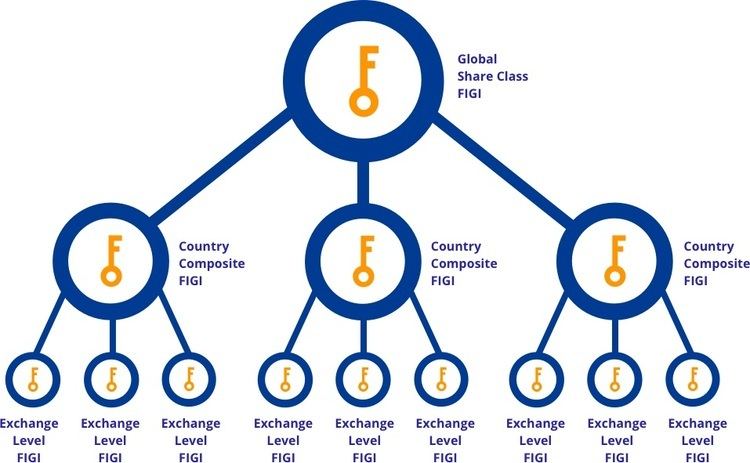Acronym FIGI | Introduced 2009 No. of digits 12 | |
 | ||
Full name Financial Instrument Global Identifier No. issued Over 300 million active and inactive financial instruments | ||
The Financial Instrument Global Identifier (FIGI) (formerly Bloomberg Global Identifier (BBGID)) is an open standard, unique identifier of financial instruments that can be assigned to instruments including common stock, options, derivatives, futures, corporate and government bonds, municipals, currencies, and mortgage products. Also see: Open Data
Contents
History
In 2009, Bloomberg released Bloomberg’s Open Symbology ("BSYM"), a system for identifying financial instruments across asset classes.
As of 2014 the name and identifier called 'Bloomberg Global Identifier' (BBGID) was replaced in full and adopted by the Object Management Group and Bloomberg with the standard renamed as the 'Financial Instrument Global Identifier' (FIGI).
The Financial Instrument Global Identifier (FIGI) standard was given 'approved status' by the Object Management Group (OMG) Architecture Board as of September 2015.
Adoption
FIGIs have been adopted in the market data feeds of the following exchanges:
FIGIs have been adopted for use by the following regulators and/or been included in related Regulatory Technical Standards:
Additional notable adoption
Description
The FIGI structure is defined and copyrighted by the Object Management Group. Bloomberg L.P. is the Registration Authority and Certified Provider of the standard. FIGI have been created for more than 300 million unique securities, representing most asset classes of the financial markets. The FIGI is a 12-character alpha-numerical code that does not contain information characterizing financial instruments, but serves for uniform unique global identification. Once issued, a FIGI is never reused and represents the same instrument in perpetuity.
Unique FIGIs identify securities as well as individual exchanges on which they trade. Composite FIGIs are also issued to represent unique securities across related exchanges. For instance, Apple Inc. common stock trades on 14 exchanges in the United States. There exists a unique FIGI to identify the common stock on each individual exchange, but also a composite FIGI to represent the company's common stock traded on United States exchanges.
Equity Levels of Assignment
FIGI Structure
A FIGI consists of three parts: A two-character prefix, a 'G' as the third character; an eight character alpha-numeric code which does not contain English vowels "A", "E", "I", "O", or "U"; and a single check digit.
In total, the encoding supports more than 852 billion potential values, under the initial BBG prefix. In total, there are over 330 trillion potential available identifiers.
Structural Rules
The permissible characters for use within a FIGI are a subset of ISO 8859-1 as follows:
While the string itself is semantically meaningless, there is a specific structure that is used. The syntax rules for the twelve characters are as follows:
The purpose of the restriction is to reduce the chances that the resulting identifier may be identical to an ISIN string. (Strictly speaking, a duplicate is not a problem as the strings designate different things, but care has been taken to reduce ambiguity.) The way that ISIN is constructed is that the first two characters correspond to the country of issuance. The third character, depending on the issuing organization is typically a numeral. However, in the case of the United Kingdom, the letter "G" is assigned. As we are using the letter "G" as our third character (see below), the only combinations that may come up within ISIN that only incorporates consonants are BSG (Bahamas), BMG (Bermuda), GGG (Guernsey), GBG (United Kingdom) and VGG (British Virgin Islands). The reason for this is that the United Kingdom issues ISIN numbers for entities within its broader jurisdiction.
Letters are converted to integers as illustrated below. Using the first 11 characters and beginning at the last character in integer format and working right to left, every second integer is multiplied by two. The resulting string of integers (numbers greater than 10 become two separate digits) are added up. Subtract the total from the next higher integer ending in zero. If the total obtained when summing up the digits is a number ending in zero, then the check digit is zero.
Issuance
Unique FIGIs are published by Bloomberg L.P. and datasets are both searchable and available for download via the Bloomberg Open Symbology website. FIGIs are never reused and once issued, represent an instrument in perpetuity. An instrument's FIGI never changes as a result of any corporate action. Any interested parties may request access to the bulk and individual lookup facilities, regardless of any existing relationship with Bloomberg L.P. or lack thereof.
FIGIs are assigned to unique financial instruments on a proactive basis. Where a FIGI has not been assigned for any reason, a request can be submitted to have an identifier assigned, as long as the request is in line with the standard and stated assignment rules.
License
FIGIs and the associated metadata defined in the standard are released free into the public domain with no commercial terms or restrictions on usage. The OMG standard is governed through the Open Source MIT License.
